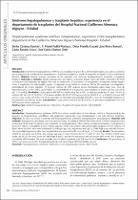Síndrome hepatopulmonar y trasplante hepático: experiencia en el departamento de trasplantes del Hospital Nacional Guillermo Almenara Irigoyen - EsSalud.
Related Resource(s)
https://revistagastroperu.com/index.php/rgp/article/view/908Date
2018Author(s)
Cardenas Ramirez, Bertha
Padilla-Machaca, P. Martin
Mantilla Cruzatti, Omar
Rivera Romaní, José
Rondón Leyva, Carlos
Chaman Ortiz, José Carlos
Metadata
Show full item recordAlternate title
Hepatopulmonar syndrome and liver transplantation: experience in the transplantation
department of the Guillermo Almenara Irigoyen National Hospital - EsSalud
Abstract
Introducción: El síndrome hepatopulmonar (SHP) es una complicación grave de la enfermedad hepática, la cual se caracteriza
por la presencia de vasodilatación intrapulmonar e hipoxemia progresiva, siendo el trasplante de hígado el único tratamiento
efectivo. Objetivo: Mostrar nuestros resultados de los pacientes con síndrome hepatopulmonar sometidos a trasplante
hepático. Materiales y métodos: Estudio retrospectivo, descriptivo y trasversal. Desde marzo del 2000 a diciembre del 2016
se realizaron 226 trasplantes de hígado. Del total, se excluyeron a 25 pacientes: 12 retrasplantes, 9 trasplantes dobles higadoriñon, 2 trasplantes con falla hepática aguda, 2 trasplantes en pacientes no cirróticos. De los 201 pacientes con diagnóstico
pretrasplante de cirrosis hepática, 19 tuvieron criterios de SHP; quienes fueron distribuidos según edad, sexo, nivel de
hipoxemia (pO2
), score CHILD, score MELD. La reversibilidad de la hipoxemia post trasplante se midió con una cutt off de
p02
>75 mmHg. Resultados: La prevalencia del SHP en nuestra serie fue 9,45%. La edad promedio fue 41 años (14-65); la
relación M/F de 1,65. El 78,94% (15/19) fueron adultos. 89,5% (17/19) fueron score de CHILD B y C, y el 68,4% tuvieron SHP
severo y muy severo. En el 94,11% de los pacientes se demostró reversibilidad del SHP. La tasa de mortalidad temprana en
los pacientes con SHP fue 10,4%. Conclusiones: La prevalencia del SHP fue del 9,45%. Los pacientes trasplantados con y sin
SHP tuvieron similar sobrevida Introduction: Hepatopulmonary syndrome (HPS) is a serious complication of liver disease, which is characterized by the
presence of intrapulmonary vasodilation and progressive hypoxemia. Liver transplantation is the only effective treatment.
Objective: To show our results of patients with hepatopulmonary syndrome undergoing liver transplantation. Materials and
methods: Retrospective, descriptive and cross-sectional study. From March 2000 to December 2016; 226 liver transplants were
performed. Of the total, 25 patients were excluded: 12 retransplantation, 9 liver-kidney combined transplants, 2 transplants for
acute liver failure, 2 transplants in non-cirrhotic patients. Of the 201 patients with pretransplant diagnosis of liver cirrhosis, 19
filled criteria for SHP; who were distributed according to age, sex, hypoxemia level (pO2
), Child-Pugh score and MELD score.
The reversibility hypoxemia after liver trasplantation was measured with a cut-off of p02
>75 mmHg. Results: The prevalence
of SHP in our series was 9.45%. The average age was 41 years (14-65); the M / F ratio of 1.65. The 78.94% (15/19) were
adults. 89.5% (17/19) were Score of Child-Pugh B and C, and 68.4% had severe and very severe SHP. In 94.11% of patients,
reversibility SHP founded. The early mortality rate (30 days) in patients with SHP was 10.4%. Conclusions: The prevalence of
HPS in our series was 9.45%. Transplanted patients with and without SHP had similar survival.
Collections
- Artículos científicos [890]






